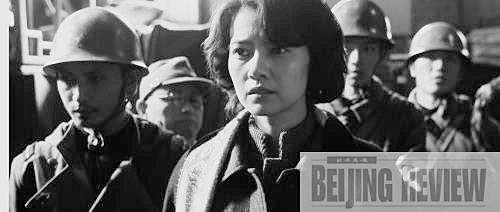|
 |
|
Gao Yuanyuan plays the role of Chinese teacher Jiang Shuyun (COURTESY OF CHUAN PRODUCTION FILM STUDIO) |
Wang Weixing, Deputy Director of the Institute of History under the Jiangsu Academy of Social Sciences, supports Lu's opinion. As one of the experts invited to be a consultant on the movie, Wang was in charge of the historical aspects. He told Dalian-based Peninsular Morning Daily that during the Nanjing Massacre, there were indeed some Japanese soldiers committing suicide.
"The war distorted their humanity. No matter whether the movie is evolved from the perspective of Chinese or Japanese, human sympathy was at the core of the movie." Wang said.
The destiny of "comfort women," or those local women who were used as sex slaves by the Japanese army, was also reflected in the movie. It is the first time in China that a movie has broached this topic. Lu said that all the screen time given to this subject was based on a great deal of historical research and evidence.
Being objective and calm when shooting the movie was a requirement that Lu set for himself. He said he wanted the calmness to flow to the audience, despite the traumatic subject matter.
The movie impressed Chinese audiences, despite the fact that they already knew the history of that period from school textbooks, other movies or previous literary works.
Zhang Zhe, 25, who works at a construction company in Beijing, told Beijing Review that he felt heaviness and oppression in his heart after watching the film. "I think more young Chinese should go to watch the movie, and the history should not be ignored or forgotten," he said, adding that the spirit shown by those Chinese who resisted bravely for the dignity of the nation should be learned by young people today.
Why make it?
On many occasions, Director Lu stressed that he wants to restore the true face of the Chinese during the war through the movie. He said that many historical materials that he had read showed that Chinese people had bravely resisted the Japanese invasion in Nanjing, including fierce street fighting. The plot of the resistance of a Chinese officer named Lu Jianxiong (played by famous actor Liu Ye) was based on such historical records.
Lu said that the biggest advantage of shooting the film was that he had an opportunity to read a good number of diaries of Japanese soldiers during the invasion. The role of the Japanese soldier who committed suicide was based on the diaries of several Japanese soldiers. Another leading role in the film, Jiang Shuyun, a teacher in the international safety zone (a demilitarized zone for Chinese civilians set up before Japanese troops broke through the Chinese defense), was also based on the diaries of some Chinese teachers at that time. One of the diaries said that there was a Chinese female teacher who saved six men by changing into different clothes before eventually being found out by Japanese soldiers.
"I wanted to show how humans face death, and how they maintain their dignity before death," Lu said.
He said that his film aims to express the rethinking of humans toward war. Lu said in his blog that this movie is dedicated to the memory of Chinese-American writer Iris Chang who wrote a book, called The Rape of Nanking, on the history of the Nanjing Massacre, and to all other people who fight for truth in the dark.
What is worth mentioning is that Chinese audiences recognized the performance of Japanese actors in the movie. During a public screening of the film in Liaoning Province, one of the three provinces in northeast China under Japanese occupation in 1931-45, many Chinese warmly applauded the courage and performance of the Japanese actors in the movie.
Bringing history alive
In order to effectively shoot the movie, a 53-hectare set depicting the city of Nanjing in 1937 was built in Changchun, northeast China's Jilin Province. It took six months and cost 15 million yuan ($2 million).
| 